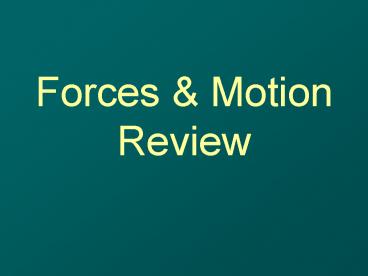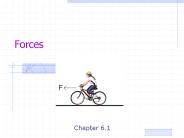Forces - PowerPoint PPT Presentation
1 / 44
Title: Forces
1
Forces MotionReview
2
Describe Acceleration
3
Describe Acceleration
- A change in velocity which may be
- A change in speed
- Starting
- Stopping
- Speeding up
- Slowing down
- A change in direction
- Acceleration is caused by unbalanced forces
More
4
Describe Acceleration
- Deceleration is also called negative acceleration
- it means an object is slowing down - When acceleration is calculated, it may be a
negative number
5
Describe Speed
6
Describe Speed
- A way to describe motion
- Average speed - Rate of motion calculated by
dividing the distance traveled by the amount of
time it takes to travel that distance - Constant speed - Speed that does not change
- Instantaneous speed - Speed of an object at any
given time
7
What is the formula used to calculate speed?
8
What is the formula for calculating speed?
- Speed is calculated by dividing distance by time
9
Calculate This Speed
- A football field is about 100 m long. If it takes
a person 20 seconds to run its length, how fast
was the football player running?
10
Calculate this Speed
- A football field is about 100 m long. If it takes
a person 20 seconds to run its length, how fast
was the football player running? - Speed Distance Time
- Speed 100 m 20 s
- Speed 5m/s
Remember to include the UNITS!!
11
Explain Balanced Forces
12
Explain Balanced Forces
- When all the forces acting on an object balance
each other - Balanced forces do not cause a change in motion
13
Describe Friction
14
Describe Friction
- Force that resists motion between two touching
surfaces - Acts in the opposite direction of the objects
motion - Produces heat
15
Explain Inertia
16
Explain Inertia
- Moving objects tend to continue moving unless
acted upon by an unbalanced force - Objects at rest tend to stay at rest unless acted
upon by an unbalanced force - The more mass an object has, the more inertia it
has - More massive objects are harder to start moving
and stop moving - Smaller objects are easier to start and stop
moving
More
17
Explain Inertia
- Newtons First Law on Motion describes the idea
of inertia - An object at rest or in constant motion is acted
upon by balanced forces an unbalanced force
will change the motion - Acceleration of an object at rest or in constant
motion is 0 m/s/s (no motion)
18
Explain Newtons First Law of Motion
19
Explain Newtons First Law of Motion
- Describes the idea of inertia
- Click the link below to observe the law
- http//archive.ncsa.uiuc.edu/Cyberia/VideoTestbed/
Projects/NewPhysics/newtons_1.html - When you are finished, click the back button on
your browser to return to this tutorial
20
Explain Newtons Second Law of Motion
21
Explain Newtons Second Law of Motion
- Describes motion created by unbalanced forces
- Mass and acceleration change in opposite ways
- The more mass an object has, the more force it
take to accelerate the object, the slower it
accelerates - The less mass an object has, the less force it
take to accelerate the object, the faster it
accelerates
More
22
Explain Newtons Second Law of Motion
- Click on the link below to observe the law
- http//archive.ncsa.uiuc.edu/Cyberia/VideoTestbed/
Projects/NewPhysics/newtons_2.html - When you are finished, click the back button on
your browser to return to this tutorial
23
Explain Newtons Third Law of Motion
24
Explain Newtons Third Law of Motion
- Describes why forces act in pairs
- For every action there is an equal and opposite
reaction - Action and reaction forces are equal forces
acting in opposite directions on different
objects
25
Explain Newtons Third Law of Motion
Click the link below to observe the
law http//archive.ncsa.uiuc.edu/Cyberia/VideoTes
tbed/Projects/NewPhysics/newtons_3.html
26
Distinguish Between Speed Velocity
27
Distinguish Between Speed and Velocity
- Speed describes distance and time
- Velocity describes distance, time, and direction
28
How Can Forces Affect Objects?
29
How Can Forces Affect Objects?
- Slow them down
- Speed them up
- Stop them
- Start them
- Change their direction
- Change their shape
30
Interpret The Graph Below
31
Interpret The Graph Below
The graph shows an object which is not moving (at
rest). The distance stays the same as time goes
by because it is not moving.
32
Interpret The Graph Below
33
Interpret The Graph Below
The graph showsthat the objects distance
increases as time passes.The object is moving
and so it has velocity. The straight line shows
it is a constant (not changing).
34
Interpret The Graph Below
35
Interpret The Graph Below
Just like the previous graph, this graph shows
an object moving with constant velocity
36
Interpret The Graph Below
37
Interpret The Graph Below
The curve in the graph shows that the objects
velocity is changing as time passes. This is
acceleration.
38
Interpret The Graph Below
39
Interpret The Graph Below
In the first part of the graph the object is
moving with constant velocity. In the second
part of the graph the object is at rest (not
moving). In the third part the object is again
moving with constant velocity.
40
Interpret The Graph Below
41
Interpret The Graph Below
The graph showsthat the objects velocity does
not change as time passes. It shows constant
velocity.
42
Interpret The Graph Below
43
Interpret The Graph Below
The graph showsthat the objects velocity is
increasing as time passes it is
accelerating. The straight line shows that it is
constant acceleration.
44
Click here for more review
- http//www.usoe.k12.ut.us/curr/science/sciber00/8t
h/forces/sciber/intro.htm































